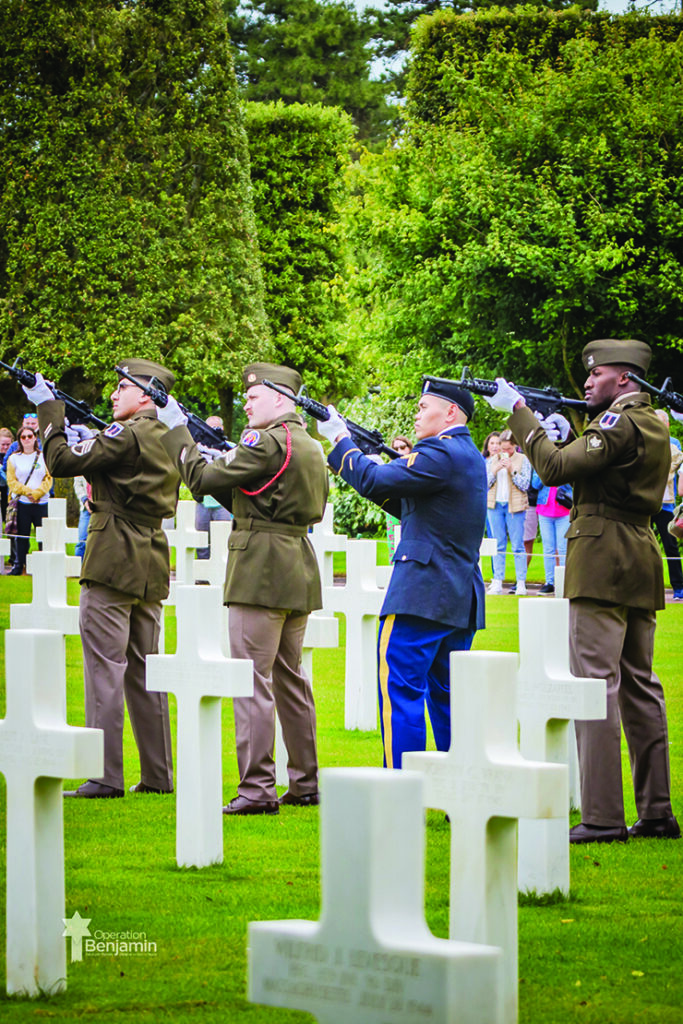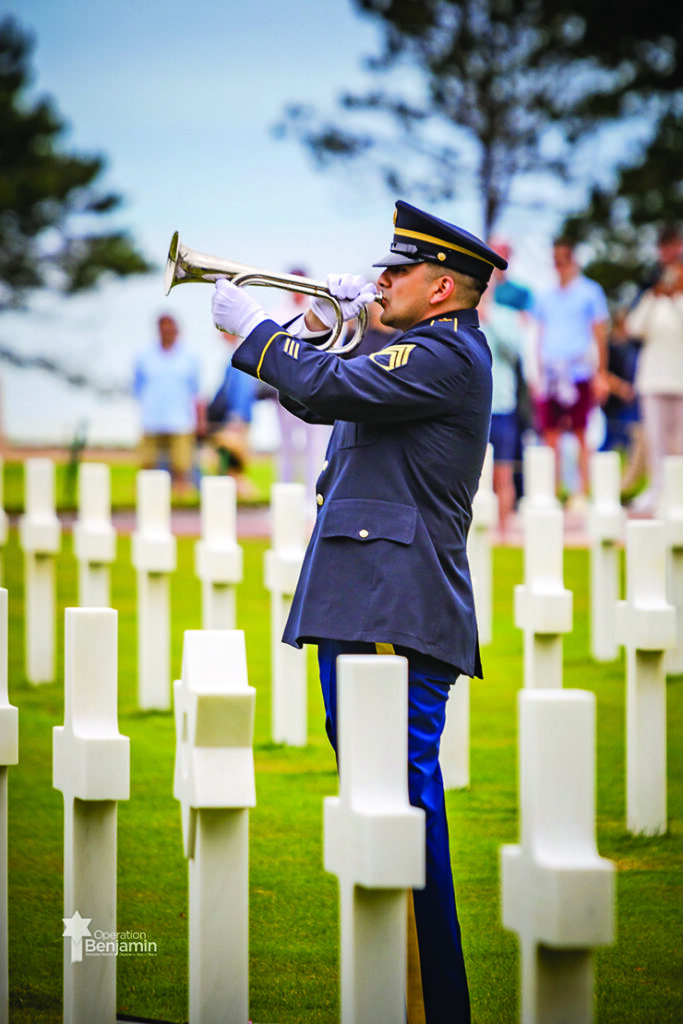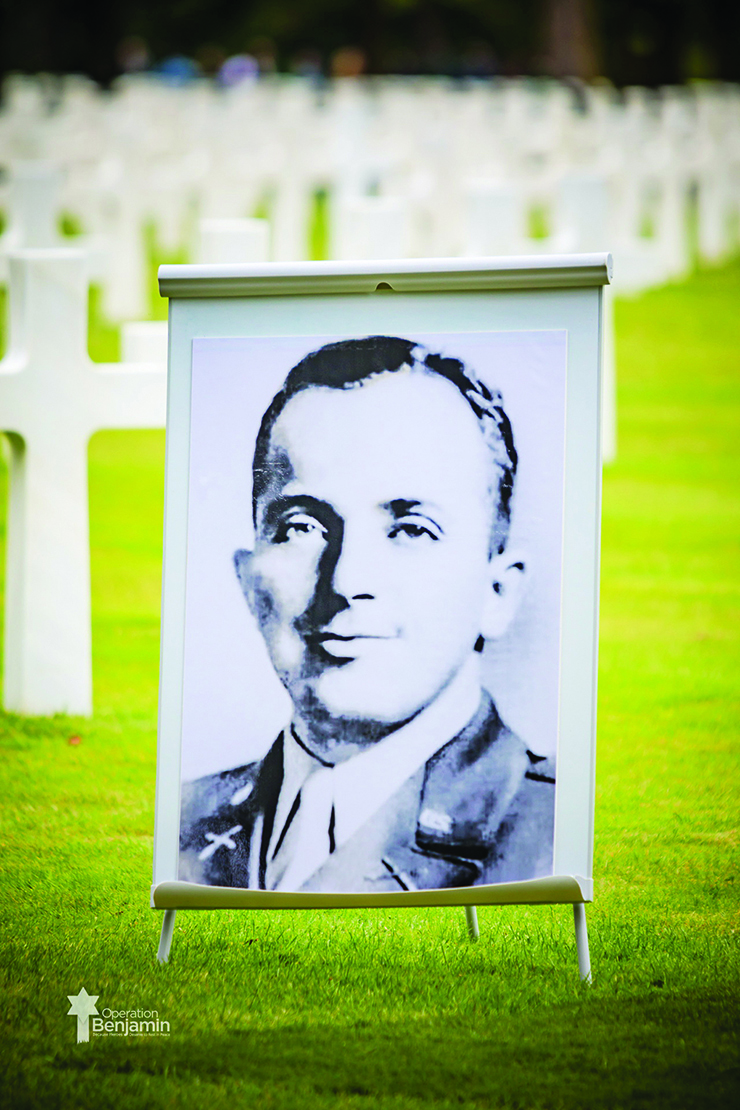
On Sunday, June 23, the 80th anniversary of his death, the remains of 1st Lt. Nathan B. Baskind, son of the late Lena (Shapiro) and Abraham Baskind of Pittsburgh, received a proper burial according to Jewish law, off to the side of Normandy American Cemetery in France.
Baskind, drafted at age 26 in 1942, stormed Utah Beach in Normandy on D-Day as part of the US Army’s 899th Tank Destroyer Battalion-Company C. Ambushed and captured while fighting in the Battle of Cherbourg, he died of his injuries in a German hospital on that same day, June 23.

Listed as missing in action, Baskind lay buried in a mass grave with 23 German soldiers. After the war, his remains were moved to another common grave holding 51 enemy soldiers at the Marigny German War Graves Cemetery. His parents, older brother, twin sister and other relatives were left with memories of a cherished young man and a mystery.
Fast forward fourscore years, and with the help of local genealogist Eric Feinstein; Shalom Lamm of Operation Benjamin (OB); his partner, Rabbi Dr. Jacob J. Schacter; modern DNA testing; and much negotiating, Baskind’s remains were uncovered and exhumed from the German mass grave. About 150 attendees from various parts of the world gathered at the religious burial on Sunday.
Also in attendance were Brig. Gen. Dirk Backen of Germany; Charles Djou, secretary of the American Battle Monuments Commission; and Consul Elizabeth Webster, who assumed her duties as U.S. Consul for Western France in August 2021.

After initially receiving the lead from Feinstein, Lamm consulted the esteemed Rabbi Asher Weiss of Jerusalem, who suggested and approved current DNA testing. With his go-ahead, Lamm returned to Berlin.
Only because the German government already had a request from a German family to exhume their relative’s remains did they allow Lamm to send in an American forensic team. To permit the grave to be opened, they stipulated the addition of German and French forensic teams. Ironically, that caveat benefited OB by allowing the work to be completed within the minimally allotted time.
The discovery of Baskind’s remains in the mass grave started with a name and a hunch by Feinstein. A genealogist by profession, Feinstein said he is “constantly looking at databases,” clarifying, “I did all my research online.”

Feinstein, of Clifton, said he works with so many clients that he goes to all new databases. Russian POWs were his interest, but as he searched the website of the Volksbund, the German War Graves Commission, he found it possible to search surnames on their website. He stated that German and Russian war records from WWI and WWII are well-preserved, unlike American records, as he recounted the tremendous amount lost in a 1973 fire at the National Personnel Records Center in St. Louis.
Russian hospital records are available online, Feinstein noted, adding that German Field Hospital records were not destroyed. According to Feinstein, although they are not published publicly, Berlin has those records in their archives. He had someone do the research in Berlin, and when Feinstein saw the name Nathan Baskind on the list, it struck a chord.
Recalling that he has a Jewish relative with the family name of Baskind, Feinstein was curious as to why, having the name Nathan, “not a German name,” Nathan Baskind was buried at the German cemetery. Baskind, a Purple Heart recipient listed as MIA on the memorial plaque in the Normandy American Cemetery, had Feinstein puzzled.

(Credit: Anibas Photography)
Insisting something was wrong, Feinstein, after surmising from the name that Baskind was Jewish, gathered all the clues possible to determine that his suspicion was correct. With no DNA testing available, learning the names of Baskind’s parents and the fact that they raised him in Pittsburgh made Feinstein believe the soldier buried in the mass grave with Germans, with no visible “H” for Hebrew on his military dog tags, was Jewish.
Feinstein said that 9,000 soldiers are buried in Normandy, and of that, 2.5 % are Jews who fell on the battlefield, meaning 250 Jews are likely buried there. “With only about 150 Jews accounted for,” noted Feinstein, “that means there are 100 missing Jewish bodies.”
Operation Benjamin, named after the first recovered Jewish soldier, honors Private Benjamin Garadetsky, whose remains were buried under a Latin cross at the Normandy American Cemetery in France. His was Operation Benjamin’s first successful marker change.
Not wanting the enemy to know that they were Jewish, many soldiers used different religions on their dog tags in case they were captured. When Garadetsky was found buried under a Christian cross in France, they thought by his name that he must be Jewish and contacted his descendants. OB moved his grave to the American Cemetery under a Star of David in 2018.
Feinstein knew of the plight of OB and Shalom Lamm, a co-founder of the nonprofit. Recounting their mission, “dedicated to finding World War I and World War II American Jewish soldiers mistakenly buried under a Christian cross and moving their remains to a burial under a Star of David,” prompted Feinstein to contact Lamm.
After checking the German War Graves records, Lamm contacted Feinstein to tell him the family had thought Baskind was missing in action and that 80 years later, with his discovery and the help of DNA testing, they were able to give him a proper Jewish burial and bring closure for the living family members. Baskind’s reinterment marks successfully moving a total of 25 graves of Jewish soldiers to rest under a Star of David.
Bethany Mandel, spokesperson for OB, stated that Feinstein is incredible. “By dumb luck and Feinstein’s ingenuity,” Mandel went on, “he brought the information to OB so a wrong could be righted.”
Feinstein remarked of Baskind, “Unbelievably they did identify his remains with DNA testing.” Seeing the Stars and Stripes American military newspaper cover the story of Baskind’s remains being transferred from the German to the American Military Cemetery in Normandy was baffling to Feinstein at first. Then, it was pointed out to him that it was newsworthy because the feeling is, “If you fight for this country, you make a sacrifice, we have your back, we fight for you.”
Lamm keeps Feinstein informed even before things go public. That’s his way of thanking him for the bona fide, gratis lead. Feinstein said that Lamm believes in making a “Kiddush Hashem,” especially with the current atmosphere in the world and the rise in antisemitism. He implored that we must let everyone know that Jewish people gave their lives for their country.
Samantha Baskind, Ph.D., began working with OB when Lamm, seeking living relatives of Nathan Baskind, unexpectedly contacted her. She spoke at the service in Normandy on Sunday honoring her great-uncle Nathan, whom she only knew from a picture and her father’s lore about his beloved uncle.
For inquiries regarding Operation Benjamin, contact:
Shalom Lamm, Chief Historian and Co-Founder, Operation Benjamin, at [email protected] or 1-917-282-7375 or visit www.operationbenjamin.org
Sharon Mark Cohen, MPA, believes that everyone deserves a legacy. Follow her at sharonmarkcohen.com.













